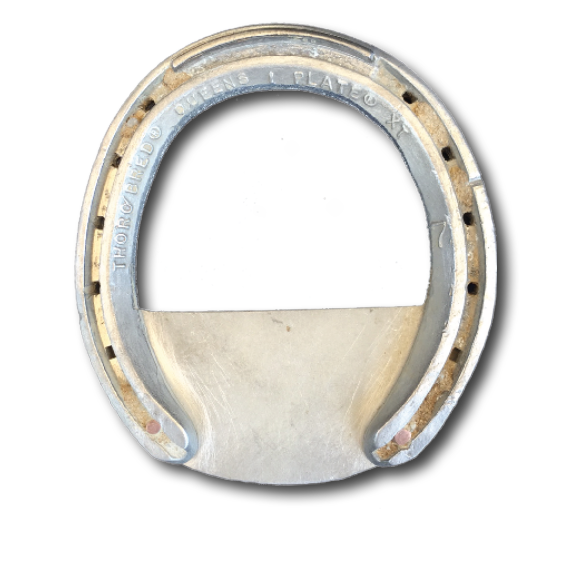Home > Horse Care > Hoof Care > The ‘Pharoah Plate’: A champion’s lucky horseshoe
The ‘Pharoah Plate’: A champion’s lucky horseshoe
- November 10, 2020
- ⎯ Fran Jurga
If you don’t believe that a horseshoe brings good luck, consider the case of American Pharoah and what I like to call his “Pharoah plate.” A shoe with an unusual, customized heel plate not only carried him to his Triple Crown victory this spring—without it, he might not be running at all.
Last fall, after racking up two consecutive wins in September 2014, the promising bay colt stayed in the barn while other top 2-year-olds raced in the Breeders’ Cup Juvenile in November. A left front foot lameness described vaguely as a “deep bruise” had kept American Pharoah out of the race.

With an eye toward prepping his colt for the 2015 racing season, on October 29, 2014, trainer Bob Baffert called in farrier Wes Champagne, who has a reputation as a problem solver. Champagne cares for about 15 of Baffert’s “special needs” horses.
Champagne cut a sheet of thin aluminum alloy to the shape of a shoe with a plate to cover the rear portion of the foot while leaving the leading portion of the sole exposed. The plate protects most of the frog and the bar area of the caudal foot from impact as the horse runs. It differs from a hospital plate, in which a protective full plate goes between the shoe and the ground, in that the aluminum lies between the hoof and the shoe. Champagne had experimented with welding the plate in place but ultimately decided that rivets worked better. Only one shoe is modified. “I’m not one of those who worries about balancing out the two front feet with the exact same shoes,” Champagne says.
____________________________________________________________
For your library:
American Pharoah: The Untold Story of the Triple Crown Winner’s Legendary Rise
[Disclaimer: EQUUS may earn an affiliate commission when you buy through links on our site. Products links are selected by EQUUS editors.]
____________________________________________________________
American Pharoah has been wearing the modified shoe since October 2014, and it’s staying on, according to Champagne. The colt wore some version of the plate for the first six of his races this year, including the Triple Crown races, and he earned decisive victories in each. “At this point, I’m afraid to take it off,” Baffert told the Daily Racing Form in April, before the Kentucky Derby.
Champagne may adjust the shape of the shoe depending on racing conditions. Sometimes, American Pharoah might wear a more “eggbar” design, in which the rear of the plate extends beyond the edge of the hoof, to provide more support. However, Champagne says, “Racing in the Kentucky Derby with 20 other horses can be rough.” For that race, the plate was trimmed closer to the exact contours of the shoe’s heel to prevent injury in the event that he might have been stepped on or tangled hooves with others at the gate. He ran so well with the shoe that it was left on for the Preakness Stakes.
Champagne did re-shoe American Pharoah before he left for New York to run in the Belmont Stakes, but that was to change the shoe, not the plate. Churchill Downs, home of the Kentucky Derby, does not allow horses to race with “low toe” shoes—those with “low” (less than 4 millimeters) toe grabs in the front. For the Belmont, American Pharoah returned to low toes in front.
So what sort of interesting or high-tech shoes did the Triple Crown winner wear on his other feet? Wes Champagne is a pioneer of adhesive horseshoeing, and it’s easy to imagine that the elite racehorses might wear shoes made of fancy, space-age materials. But, no. American Pharoah wears straightforward, aluminum alloy, nailed-on shoes—the standard Queens Plate XTs by Thoro’Bred Racing Plate Company of California. His shoes look like the same ones all the other horses at American racetracks wear on a Saturday afternoon.
But there’s often more to a racing plate than meets the eye, especially when someone like Wes Champagne has been tampering with the temper of the aluminum alloy. “Tempering” is the process by which materials such as metals or glass are hardened by repeated heating and cooling.
“I take the temper out of the shoes so they’re not so rigid,” Champagne says. You could flex these shoes in your hand. Champagne compares the de-tempered aluminum racing plates to the pliable plastic EasyShoe or urethane Polyflex shoe, which give the foot vertical flexibility in the heels.
The disadvantages of de-tempering might be faster wear, especially since so many of the walking surfaces at racetracks are paved. Some horses’ feet might spread with a de-tempered shoe, but Champagne said that that was preferable to holding it too tightly.
No other living farrier is able to say that they put shoes on a Triple Crown champion for all three of the races. But Wes Champagne has done more than that. He has masterminded a hoof-care formula that has kept American Pharoah running sound.
Don’t miss out! With the free weekly EQUUS newsletter, you’ll get the latest horse health information delivered right to your in basket! If you’re not already receiving the EQUUS newsletter, click here to sign up. It’s *free*!





